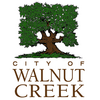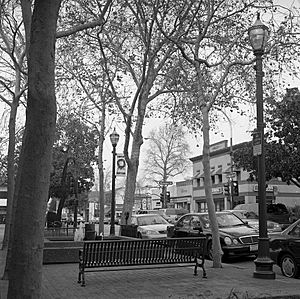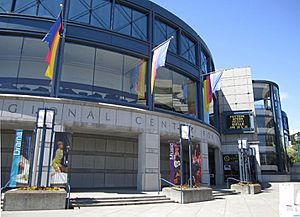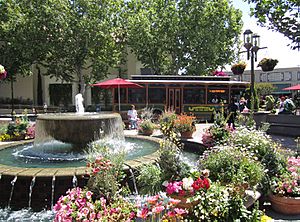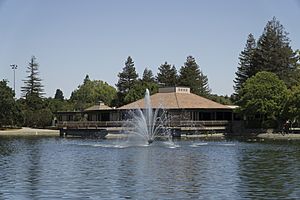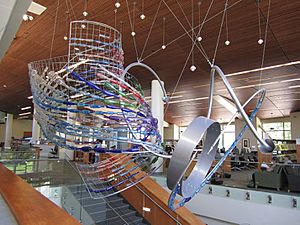Walnut Creek, California facts for kids
Quick facts for kids
Walnut Creek, California
|
||
|---|---|---|
| City of Walnut Creek | ||

Shell Ridge Open Space
|
||
|
||
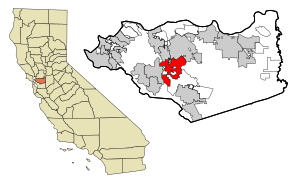
Location of Walnut Creek within California
|
||
| Country | ||
| State | ||
| County | Contra Costa | |
| First settled | 1849 | |
| Incorporated | October 21, 1914 | |
| Government | ||
| • Type | General Law | |
| Area | ||
| • Total | 19.77 sq mi (51.21 km2) | |
| • Land | 19.76 sq mi (51.18 km2) | |
| • Water | 0.01 sq mi (0.03 km2) 0.06% | |
| Elevation | 131 ft (40 m) | |
| Population
(2020)
|
||
| • Total | 70,127 | |
| • Density | 3,547.1/sq mi (1,369.40/km2) | |
| Time zone | UTC-8 (PST) | |
| • Summer (DST) | UTC-7 (PDT) | |
| ZIP codes |
94595–94598
|
|
| Area code(s) | 925 | |
| FIPS code | 06-83346 | |
| GNIS feature IDs | 1660120, 2412174 | |
Walnut Creek is a microclimate city in Contra Costa County, California, United States, located in the East Bay region of the San Francisco Bay Area, about 16 miles (26 km) east of the city of Oakland. With a total population of 70,127 per the 2020 census, Walnut Creek serves as a vibrant hub for its neighboring cities because of its location at the junction of the highways from Sacramento and San Jose (I-680) and San Francisco/Oakland (SR-24), and its accessibility by BART. Its active downtown neighborhood features hundred-year-old buildings and extensive high-end retail establishments. Walnut Creek has a median home sold price of $1,572,500 (excluding Rossmoor) with a highest home sold price of $4,120,500 as of March 2022. The city shares its borders with Lafayette, Alamo, Pleasant Hill, and Concord.
History
There are three bands of Bay Miwok Indians associated with early Walnut Creek: the Saclan, whose territory extended through the hills east of present-day Oakland, Rossmoor, Lafayette, Moraga, and Walnut Creek; the Volvon (also spelled Bolbon, Wolwon, and Zuicun) at Mt. Diablo; and the Tactan at Danville and Walnut Creek, on San Ramon Creek.
Today's Walnut Creek is located amidst the earlier site of four Mexican land grants. One of these land grants – measuring 18,000 acres (73 km2) – belonged to Juana Sanchez de Pacheco, who deeded it to her two grandsons. Ygnacio Sibrian, one of the grandsons, created the first roofed home in the valley in about 1850. The grant was called Rancho Arroyo de Las Nueces y Bolbones, named after the principal waterway, Arroyo de las Nueces (Walnut Creek) as well as for the local group of indigenous Americans (Bolbones). The Arroyo de las Nueces was named for the occurrence in the valley of the native species of walnut tree, the California Walnut.
With the coming of American settlers following the Mexican-American War, a small settlement called "The Corners" emerged, named because it was the place where roads from Pacheco and Lafayette met. The site of this first American settlement is found today at the intersection of Mt. Diablo Boulevard and North Main Street. The first town settler was William Slusher, who built a dwelling on the bank of Walnut Creek, which was called "Nuts Creek" by the Americans in 1849. In the year 1855, Milo Hough of Lafayette built the hotel named "Walnut Creek House" in the corners. A blacksmith shop and a store soon joined the hotel, and a year later, Hiram Penniman (who built Shadelands Ranch) laid out the town site and realigned the Main Street of today. Two decades later, the community changed its name from The Corners to Walnut Creek.
In December 1862 a United States Post Office was established, and the community was named "Walnut Creek". The downtown street patterns laid out in 1871–1872 by pioneer Homer Shuey on a portion of one of his family's large cattle ranches are still present today.
Walnut Creek began to grow with the arrival of Southern Pacific Railroad service in 1891. On October 21, 1914, the town and the surrounding area of 500 acres (2.0 square kilometres)), were incorporated as the 8th city in Contra Costa County. A branch line of the Southern Pacific railroad ran through Walnut Creek until the late 1970s. The East Bay Regional Park District's Iron Horse Trail, used by walkers, runners and bikers, runs over what were portions of that branch line. The mainline of the Sacramento Northern Railway passed through Walnut Creek. Both railroads had stations here. Today, the Pittsburg/Bay Point – SFO Line line of the Bay Area Rapid Transit (BART) serves Walnut Creek with a station adjacent to Highway 680.
With the 1951 opening of the downtown Broadway Shopping Center (now Broadway Plaza), Contra Costa County's first major retail center, the city took off in a new direction, and its population more than quadrupled – from 2,460 in 1950 to 9,903 in 1960.
Geography and climate
Walnut Creek is located at 37°54′23″N 122°03′54″W / 37.90639°N 122.06500°W. Portions lie in both the San Ramon Valley and the Ygnacio Valley below the western slopes of Mount Diablo. According to the United States Census Bureau, the city has a total area of 19.8 sq mi (51.2 km2), 0.06 percent of which is water. Walnut Creek – the actual waterway that runs through town – has been routed underneath downtown through a series of tunnels starting at the southwest end of Macy's and ending just southwest of Maria Maria Restaurant.
Open space
Walnut Creek owns more open space per capita than any other community in the state of California. In 1974, Walnut Creek voters approved a $6.7 million bond measure that allowed the city to purchase 1,800 acres (730 ha) of undeveloped hillsides, ridge lines, and park sites. Walnut Creek owns parts of Lime Ridge Open Space, Shell Ridge Open Space, Acalanes Ridge Open Space, and Sugarloaf Open Space.
The East Bay Regional Park District operates Diablo Foothills Regional Park and Castle Rock Regional Recreation Area, both in Walnut Creek.
Climate
Walnut Creek's warm summer Mediterranean climate (Köppen climate classification Csb) is typical of California's interior valleys. In summer, high pressure is in control of the region, leading to almost unbroken sunshine and virtually no precipitation. Days start out cool but quickly warm up, with high temperatures normally in the 80s Fahrenheit (27 to 32 °C). Temperatures of 100 °F (38 °C) or hotter occur numerous times during heatwaves, however. In the winter, the jet stream moves far enough south so that Pacific storms can reach Walnut Creek, bringing much-needed rain – average annual rainfall approximates 20 inches (510 mm), with slight variations occurring in microclimates based on elevation and topography. During particularly cold storms, snow falls on the peak of nearby Mount Diablo, but snow in the valley floor is very rare. There are also plenty of clear, mild days in winter, often with morning frost. The climate allows for the successful cultivation of many plants and crops, being warm enough for citrus yet cold enough for apples. The Ruth Bancroft Garden is a renowned botanical garden that showcases the diversity of plants that can be successfully grown.
| Climate data for WALNUT CREEK 2 ESE, California (1893–1974) | |||||||||||||
|---|---|---|---|---|---|---|---|---|---|---|---|---|---|
| Month | Jan | Feb | Mar | Apr | May | Jun | Jul | Aug | Sep | Oct | Nov | Dec | Year |
| Record high °F (°C) | 80 (27) |
83 (28) |
97 (36) |
94 (34) |
103 (39) |
109 (43) |
115 (46) |
112 (44) |
114 (46) |
101 (38) |
89 (32) |
76 (24) |
115 (46) |
| Average high °F (°C) | 55 (13) |
61 (16) |
65 (18) |
71 (22) |
76 (24) |
83 (28) |
88 (31) |
87 (31) |
84 (29) |
77 (25) |
66 (19) |
56 (13) |
72 (22) |
| Average low °F (°C) | 36 (2) |
38 (3) |
40 (4) |
43 (6) |
47 (8) |
52 (11) |
54 (12) |
54 (12) |
52 (11) |
46 (8) |
41 (5) |
37 (3) |
45.0 (7.2) |
| Record low °F (°C) | 17 (−8) |
21 (−6) |
24 (−4) |
28 (−2) |
32 (0) |
34 (1) |
38 (3) |
41 (5) |
36 (2) |
27 (−3) |
23 (−5) |
18 (−8) |
17 (−8) |
| Average precipitation inches (mm) | 4.52 (115) |
3.62 (92) |
2.47 (63) |
1.38 (35) |
0.56 (14) |
0.14 (3.6) |
0.01 (0.25) |
0.04 (1.0) |
0.24 (6.1) |
1.05 (27) |
2.26 (57) |
3.83 (97) |
20.12 (510.95) |
| Average precipitation days (≥ 0.01 in) | 10 | 9 | 8 | 5 | 3 | 1 | 0 | 0 | 1 | 3 | 6 | 9 | 53 |
Public transit and bike trails
The city hosts two BART stations, Walnut Creek station and Pleasant Hill station (in the unincorporated area known as Contra Costa Centre Transit Village). BART provides direct service from Walnut Creek to San Francisco, heading west, and Pittsburg, heading east. Other cities such as Berkeley and Fremont can be accessed via transfers.
Central Contra Costa Transit Authority (County Connection/CCCTA) provides bus service throughout Walnut Creek and Contra Costa County at a modest cost. County Connection also operates three free weekday shuttles within city limits: the Downtown Trolley/Route 4 loops from Walnut Creek BART to Broadway Plaza; Route 5 runs from Walnut Creek BART to Creekside; and Route 7, which runs from Pleasant Hill BART to Shadelands Business Park.
Walnut Creek is transected by the Iron Horse Trail (running north/south) through its downtown, as well as the Contra Costa Canal Trail (running east/west) at the north end of the city. Both these trails, in addition to city bike lanes, make bicycle transportation feasible for both recreation and an alternative commute.
Demographics
| Historical population | |||
|---|---|---|---|
| Census | Pop. | %± | |
| 1880 | 94 | — | |
| 1920 | 538 | — | |
| 1930 | 1,014 | 88.5% | |
| 1940 | 1,578 | 55.6% | |
| 1950 | 2,420 | 53.4% | |
| 1960 | 9,903 | 309.2% | |
| 1970 | 39,844 | 302.3% | |
| 1980 | 54,033 | 35.6% | |
| 1990 | 60,569 | 12.1% | |
| 2000 | 64,296 | 6.2% | |
| 2010 | 64,173 | −0.2% | |
| 2020 | 70,127 | 9.3% | |
| U.S. Decennial Census | |||
The 2010 United States Census reported that Walnut Creek had a population of 64,173. The population density was 3,246.2 people per square mile (1,253.4/km2). The racial makeup of Walnut Creek was 50,487 (78.7 percent) White, 1,035 (1.6 percent) African American, 155 (0.2 percent) Native American, 8,027 (12.5 percent) Asian, 125 (0.2 percent) Pacific Islander, 1,624 (2.5 percent) from other races, and 2,720 (4.2 percent) from two or more races. Hispanic or Latino of any race were 5,540 persons (8.6 percent).
The Census reported that 63,171 people (98.4 percent of the population) lived in households, 176 (0.3 percent) lived in non-institutionalized group quarters, and 826 (1.3 percent) were institutionalized.
There were 30,443 households, out of which 6,363 (20.9 percent) had children under the age of 18 living in them, 13,305 (43.7 percent) were opposite-sex married couples living together, 2,071 (6.8 percent) had a female householder with no husband present, 844 (2.8 percent) had a male householder with no wife present. There were 1,286 (4.2 percent) unmarried opposite-sex partnerships, and 298 (1.0 percent) same-sex married couples or partnerships. 11,884 households (39.0 percent) were made up of individuals, and 6,424 (21.1 percent) had someone living alone who was 65 years of age or older. The average household size was 2.08. There were 16,220 families (53.3 percent of all households); the average family size was 2.79.
The population was spread out, with 10,719 people (16.7 percent) under the age of 18, 3,599 people (5.6 percent) aged 18 to 24, 15,137 people (23.6 percent) aged 25 to 44, 17,653 people (27.5 percent) aged 45 to 64, and 17,065 people (26.6 percent) who were 65 years of age or older. The median age was 47.9 years. For every 100 females, there were 86.4 males. For every 100 females age 18 and over, there were 83.0 males.
There were 32,681 housing units at an average density of 1,653.2 per square mile (638.3/km2), of which 20,262 (66.6 percent) were owner-occupied, and 10,181 (33.4 percent) were occupied by renters. The homeowner vacancy rate was 2.4 percent; the rental vacancy rate was 6.7 percent. 43,079 people (67.1 percent of the population) lived in owner-occupied housing units and 20,092 people (31.3 percent) lived in rental housing units.
|
Culture
Arts companies and venues
Bedford Gallery
This 3,500-square-foot exhibition space hosts several exhibitions annually, featuring historic and modern art from contemporary artists. The gallery is a community-based facility that provides art workshops, lectures, and educational programs to the public throughout the year.
California Symphony
The California Symphony, notable for its commitment to the performance of music by American composers, has been based in Walnut Creek since its inception in 1986.
Center Repertory Company
The Center Repertory Company is the in-house theater company for the Lesher Center for the Arts. It stages six productions a year, including the annual production of A Christmas Carol.
Civic Arts Education
A community arts education program offering classes to children and adults since 1964. Classes include beginning, intermediate and expert levels in ceramics, sculpture, dance, fiber arts, digital media, photography, drama, drawing, painting, printmaking, glass, jewelry and music. The Clay Arts Guild (CAG) is a non-profit volunteer organization, established in 1964, supporting ceramics arts education under the Civic Arts Education program. An arts-based preschool and youth arts center are popular year-round programs, all part of the City of Walnut Creek's Arts Recreation & Community Services Department.
Company C Contemporary Ballet
Established in 2002, Company C commissions new work and performs historic modern ballet throughout the Bay Area. Past performances have featured the works of Twyla Tharp, Michael Smuin, Lynne Taylor-Corbett, Charles Anderson, and Antony Tudor,
Festival Opera
The Festival Opera Association was founded in Walnut Creek in 1991 to preserve and advance the operatic art form. The company produces a free Opera in the Park in Civic Park in addition to main stage performances at the Lesher Center for the Arts.
Lesher Center for the Arts
Three performance spaces (The Knight Stage 3, The Hoffman, and The Margaret Lesher theatres) and the Bedford Gallery are included in this modern building. The Center is named for Dean Lesher, newspaper publisher and founder of the Contra Costa Times.
Points of interest
- Tony La Russa's Animal Rescue Foundation (ARF)
- Castle Rock Park
- Civic Park, including seasonal outdoor skating rink
- Heather Farm Park, including Gardens at Heather Farm and all-abilities playground
- Howe Homestead Park
- Lindsay Wildlife Museum
- Mount Diablo State Park
- Open space hiking/biking trails, including Acalanes, Lime Ridge, Shell Ridge (featuring Fossil Hill trail)
- Old Borges Ranch
- Ruth Bancroft Garden
- St. Paul's Episcopal Church, featuring Carpenter Gothic chapel
- Shadelands Ranch Museum
- Walden Park Disc Golf Course
Sister cities
Walnut Creek has an active Sister Cities International program with two sister cities. Schools in the city have a yearly student-exchange with these cities.
Economy
Companies based in Walnut Creek include Central Garden & Pet (makers of the AvoDerm, Amdro, Kaytee brands, among others), American Reprographics Company, CSE Insurance Group, Maximum Games, and the PMI Group.
Education
Public K–12
Walnut Creek residents attend schools in five public school districts. The Walnut Creek School District (K–8) has five elementary schools, one magnet school (K–8), and one middle school in the city. Some residents are served by schools from the Mount Diablo Unified School District (K–12), the Acalanes Union High School District (9–12), the San Ramon Valley Unified School District (K–12), and the Lafayette School District (K–8). The following public schools are within the city limits of Walnut Creek:
- Walnut Creek School District
- Buena Vista Elementary
- Indian Valley Elementary
- Murwood Elementary
- Parkmead Elementary
- Walnut Heights Elementary
- Walnut Creek Intermediate
- Tice Creek School
- Acalanes Union High School District
- Las Lomas High School
- Acalanes Center for Independent Study
- Mount Diablo Unified School District
- Eagle Peak Montessori (charter elementary)
- Bancroft Elementary
- Valle Verde Elementary
- Walnut Acres Elementary
- Foothill Middle
- Northgate High School
Private K–12
Walnut Creek is home to several private schools, including:
- Berean Christian High School (Grades: 9–12)
- Contra Costa Christian Schools (Grades: PK–12)
- Fusion Academy Walnut Creek (Grades: 6–12)
- Garden Gate Montessori School (Grades: PK–K)
- North Creek Academy & Preschool (Grades: PK–8)
- Palmer School (Grades: K–8)
- St. Mary of the Immaculate Conception School (Grades: PK–8)
- The Seven Hills School (Grades: PK–8)
- Springfield Montessori School (Grades: PK–K)
- Walnut Creek Christian Academy (Grades: K–8)
Public libraries
The Walnut Creek Library and the Ygnacio Valley Library of the Contra Costa County Library are located in Walnut Creek. The Ygnacio Valley Branch, which opened in 1975, is also known as the Thurman G. Casey Memorial Library. Fundraising and other support is provided by the Walnut Creek Library Foundation.
On February 26, 2008, the city demolished the Walnut Creek Library, that was built in 1961 at the southern end of Civic Park. Mayor Gwen Regalia hosted a groundbreaking on the same site for the new library on May 19, 2008. The new library, designed by Group 4 Architecture, Research + Planning, Inc., has 42,000 square feet (3,900 m2) and an underground parking garage. Construction was completed in 2010 and the library was officially opened on July 17, 2010.
Notable people
- Arthur Adams, comics artist
- Matt Anger, professional tennis player
- Dan Ashley, journalist
- Ruth Bancroft, gardener, landscape architect and creator of the Ruth Bancroft Garden
- Jessica Bowman, actress, portrayed Colleen Cooper in Dr. Quinn, Medicine Woman
- Tom Candiotti, MLB pitcher
- Richard Carlson, psychotherapist, author of Don't Sweat the Small Stuff
- Curt Casali (born 1988), baseball catcher for the San Francisco Giants
- Joyce Chin, comics artist
- Dr. Alette Coble-Temple, Ms. Wheelchair America 2016, disability advocate
- TJ Cox, congressman
- Ayesha Curry, chef
- Steph Curry, NBA player
- Corey Duffel, professional skateboarder
- Kyle Gass, guitarist for Tenacious D, attended Las Lomas High School
- Lee Goldberg, writer and television producer, graduated from Northgate High School (1980)
- Dan Haren, MLB pitcher
- Brandon Harkins, professional golfer
- Jack Henderson, Artist
- Marya Hornbacher, author
- Sabrina Ionescu, basketball player
- Kristian Ipsen, U.S. diver, Olympic bronze medalist
- Kyle Jensen, baseball player
- Bessilyn Johnson, daughter of Hiram Penniman, Shadelands Ranch owner, resident of Scotty's Castle in Death Valley
- Randy Johnson, Hall of Fame MLB pitcher
- Persis Karim (b. 1962), American poet, editor, educator; born in Walnut Creek.
- Kira Kazantsev, Miss America 2015
- Tosh Lupoi, defensive line coach for Jacksonville Jaguars
- Mark "Mad Dog" Madsen, NBA player
- John A. Nejedly (1914–2006), California State Senator
- Kyle Newacheck, co-creator, co-star of Comedy Central's Workaholics
- Jason Newsted, bassist for Metallica
- Aaron Poreda, MLB pitcher
- Markie Post, television actress
- Jeff Richards, writer and featured performer on NBC's Saturday Night Live, 2001–2004
- Bill Rigney, MLB infielder, Angels' inaugural manager
- Lester Rodney, journalist, civil rights activist
- Katharine Ross, film actress, graduated from Las Lomas High School (1957)
- Leslie Carrara-Rudolph, Sesame Street puppeteer
- Greg Sestero, actor, star of cult film The Room, author of The Disaster Artist, born in Walnut Creek
- Justin Speier, MLB pitcher
- Joe Starkey, California Golden Bears and former San Francisco 49ers announcer
- The Story So Far, pop punk band
- Christy Turlington, supermodel, health activist
- Lars Ulrich, drummer for Metallica
- Joseph R. Walker, 19th-century wilderness explorer and scout
- Johnny Weekly, MLB outfielder
- Wayne A. Wiegand, library historian, author, academic
- Sherri Youngward, Christian singer and songwriter
Images for kids
See also
 In Spanish: Walnut Creek (California) para niños
In Spanish: Walnut Creek (California) para niños


